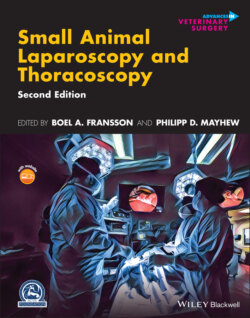Читать книгу Small Animal Laparoscopy and Thoracoscopy - Группа авторов - Страница 66
Tying the Modified Roeder Knot (Figure 2.25, Video 2.6)
ОглавлениеThe modified Roeder as discussed above is these authors' preferred slip knot in clinical MIS. In our experience, it is less complex, with less risk of air knots, than the 4SMR. We have used it without complications for ovarian pedicle ligation in live dogs, without the need for added throws.
Figure 2.23 Modified Roeder knot. This is similar to a previously described knot [19], but with an added, 4th, throw. (A) The loop end crosses posterior to the post end and a single throw is formed. The loop end is wrapped four times around in a clock‐wise fashion. (B) The loopend forms a half‐hitch around itself by moving posterior and then anterior from under the last wrap. (C) The loop end is moved from anterior to posterior immediately adjacent to the first single throw. (D) The knot is complete when there are no air‐gaps present.
Figure 2.24 Weston knot tying. (A). A right‐to‐left bite has been simulated. The needle end (green) is the post; the short (red) constitutes the loop end. The left hand is wrapping the suture around the dorsal thumb. (B). The loop end has crossed over the post, and the thumb and index finger meet and rotate down through the loop, grasping the loop end and bringing it up (posterior to anterior) through the loop to create a single throw. (C). The thumb remains positioned in the loop, and the throw is maintained at the dorsal thumb. (D). The left‐hand index and middle fingers, pointing upward (posterior to anterior direction), cross the strands by pushing the post from right to left and the loop from left to right. (E). The loop end is grasped by the left index and middle finger, which are used to pull the loop end in an anterior to posterior direction. (F). The loop end is passed under the left strand (post), and then it is grasped by the right hand and moved up again (posterior to anterior). (G). The right hand passes the loop end into the small triangular space that is formed by the two strands on the right of the thumb and the one strand to the left of the thumb. The thumb and index finger of the left‐hand grasp the loop end. (H). The Figure 8–shaped knot is pulled tighter by applying gentle and equal tension on both the post and the loop end. (I). Excessive tension on the loop (short) end will make the knot tumble, which will lock it, and the knot will not slip. Ensure that the loop end is not overtightened. The knot can now be slipped down and cinched with a knot pusher, which will tumble the knot and lock it. Additional throws are applied with intracoporeal knot‐tying technique.
Figure 2.25 Modified Roeder knot tying. The coloring is not fixed on the rope, but added to clarify post vs. loop end in this series. (A). A suture bite has been simulated. The needle end (green color) is the post; the red‐colored constitutes the loop end. (B). The loop end crosses posterior to the post and is then forming a single throw (C). The loop end is wrapped anterior to posterior 4 times around both ends (D). The loop end is passed around the loop end posterior to anterior below the last throw (E). Thus, the loop end forms a half hitch. (F). The loop end is thereafter passed (anterior to posterior) through the beginning loop hitch. (G). The completed knot ready to be cinched down with a knot pusher. (H). Cinched knot with no air.
